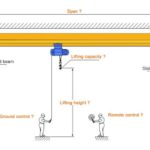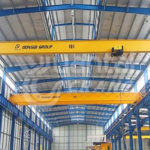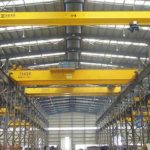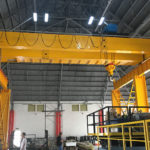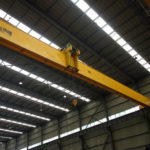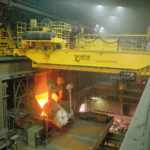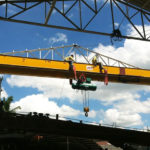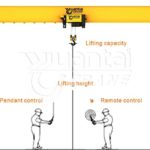A warehouse crane system refers to a combination of cranes, tracks, and associated equipment to help with material handling operations within a warehouse or distribution centre. It is designed to move heavy loads, such as pallets or containers, from one location to another within the facility. Warehouse cranes provide efficient and effective material handling solutions to optimize warehouse operations. The warehouse crane system is to enable the efficient movement of heavy loads, including pallets, containers, etc.
Cranes equipped with hoists and trolleys can do vertical lifting and horizontal movement of heavy loads. Cranes operate along tracks that are installed throughout the warehouse, allowing cranes to reach different storage locations. The warehouse crane system improves material handling by streamlining processes and optimizing storage space use. It improves efficiency by enabling faster and safer movement of heavy items.
Warehouse Overhead Crane
A warehouse overhead crane, also known as an overhead crane, operates on tracks installed on the warehouse ceiling. It is designed for lifting and moving heavy loads within the warehouse. Key features and components of a warehouse overhead crane include:


- Bridge: The bridge is the main horizontal beam of the crane, which runs along the tracks or rails. It carries the hoist and trolley system and enables the crane to traverse the length of the warehouse.
- End Trucks: End trucks are the components at the ends of the bridge that support and guide the crane along the tracks. They usually consist of wheels or rollers that run on the rails.
- Hoist and Trolley: The trolley facilitates horizontal movement along the bridge. The hoist and trolley system is attached to the bridge and allows for precise positioning of the load.
- Controls: The crane is operated using a control pendant or a Remote Control system. Operators control the movement of the crane, including hoisting, lowering, and traversing functions.
Warehouse overhead cranes offer several advantages for material handling operations, including:
- Heavy Load Capacity: They are designed to handle heavy loads, ranging from several tons to several hundred tons. That makes them suitable for lifting and moving large items within the warehouse.
- Versatile Movement: Overhead cranes can move in many directions, including horizontally along the bridge and vertically for moving loads. This versatility allows for efficient placement and transport of goods.
- Efficient Use of Space: By operating on an overhead track, the crane does not occupy floor space within the warehouse. This enables better use of the available area for storage.
- Improved Safety: Overhead cranes are designed with safety features such as limit switches, emergency stop buttons, and overload protection systems. These features ensure safe and secure lifting operations, minimizing the risk of accidents.
Warehouse Gantry Crane
A warehouse gantry crane, also known as a gantry crane, is a type of crane that is designed for material lifting within a warehouse. It consists of a horizontal bridge supported by two or more legs that run along rails installed on the floor or elevated beams. Warehouse gantry cranes play a crucial role in enhancing productivity and improving safety in warehouses.

- Lifting Capacity: Warehouse gantry cranes come in various lifting capacities. They can range from light-duty cranes with lower capacities to heavy-duty cranes capable of lifting several tons.
- Span and Height: The span of a warehouse gantry crane refers to the distance between the two supporting legs. The height refers to the distance from the ground to the bridge. The span and height are designed based on the specific needs and dimensions of the warehouse.
- Mobility: Warehouse gantry cranes can be either fixed or mobile. Fixed gantry cranes are installed on a permanent track system. Mobile gantry cranes are equipped with wheels or tracks that allow them to move along the floor. Mobile gantry cranes offer greater flexibility in moving loads between different locations.
Advantages of Warehouse Cranes
- Enhanced Lifting Capacity: Warehouse cranes can lift and move large items. This capability enables the efficient moving of goods, minimizing manual labour.
- Improved Efficiency: Cranes streamline warehouse operations by reducing the time required to move goods. They can swiftly move heavy items into the warehouse, allowing for faster order fulfilment. This increased efficiency can lead to improved productivity.
- Optimal Space Use: Warehouse cranes help maximize vertical space use in the facility. They enable efficient stacking of goods, which is particularly beneficial in high-density storage environments. Warehouse cranes increase the storage capacity of the warehouse, allowing businesses to store more goods within a small warehouse.
- Increased Accuracy: Cranes offer precise and controlled movements, enabling accurate positioning of goods. This level of control is crucial when handling fragile or sensitive items. Accurate positioning reduces the risk of product damage and improves inventory accuracy.
- Customization: Warehouse cranes can be customized to meet specific operational requirements. They can be equipped with various accessories, such as clamps and magnets to meet different needs. So warehouse cranes are suitable for a wide range of applications.
How Warehouse Crane Systems Transform Warehouse Operations
Warehouse crane systems are at the forefront of transforming warehouse operations. With the rise of e-commerce and the increasing demand for faster delivery times, these systems provide a solution that meets the need for speed, efficiency, and accuracy in order fulfilment. They enable warehouses to handle a greater volume of goods with fewer errors, ensuring that the right products are delivered to the right place at the right time.
Furthermore, the flexibility of warehouse crane systems allows for easy adaptation to changing business needs. Whether it’s scaling operations up or down, these systems can be adjusted to accommodate different product types and sizes, making them a versatile tool in the logistics arsenal.

The Future of Warehouse Crane Systems
As technology continues to evolve, so too do warehouse crane systems. The future of these systems lies in further automation and integration with other warehouse technologies such as warehouse management systems (WMS) and the Internet of Things (IoT). This integration will lead to smarter, more efficient operations, where real-time data and analytics can inform decision-making processes, optimize workflows, and predict maintenance needs.
If you have any crane needs, please feel free to contact us and we will reply to you as soon as possible.
